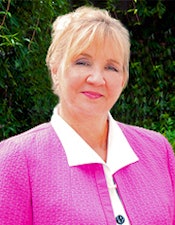
As a practice leader who understands the importance of process automation and data security, you've taken the necessary steps to implement what you're certain is a secure electronic claims and attachment process. But how can you be sure the claims documentation you're submitting is making its way to the health plan or payor in a likewise secure fashion?
 Lindy Benton is the CEO and president of Vyne.
Lindy Benton is the CEO and president of Vyne.Could it be possible that you are simply assuming -- incorrectly in many cases -- that your vendor is following a similarly secure electronic workflow for transmitting and processing these claims and attachments with the payor? That, unfortunately, is an all-too-real possibility that could be putting protected patient information at risk unless you ask how your data are being delivered.
Even if you are using an outside clearinghouse vendor for the process, there is a good possibility that not all your claims and attachments are being processed electronically, although that may be what you are expecting from your partnership. In fact, vendors are dropping claims and attachments to paper (that is, printing them) more than you might think. It's common enough that it has a name: drop shipping.
Too common a scenario
Let's examine a common claim attachment scenario more closely. You send your claim attachments to your vendor electronically, then, unknown to you, the vendor prints the claim attachments and supporting documents, then packages and sends them to the payor on your behalf. In other words, the vendor simply becomes a middleman in your claims process, adding minimal value while taking your money for the same work you could have done in the first place.
If you think this is an impossibility, that your vendor would expose your data to the security vulnerabilities of standard printing, mailing, and shipping, you should probably know that this sort of thing happens every day. For some organizations, it's standard operating practice.
Everyone assumes that all clearinghouses have direct lines to all payors, and that's not true, according to dental practice consultant Teresa Duncan, founder of Odyssey Management, a dental practice consultancy specializing in claims management.
Not every vendor has the needed electronic connection to payors, so they must drop claims and attachments to paper, pack them, and send them via carrier to the payor, Duncan noted. Doing so eliminates an audit trail and makes it nearly impossible to track the claim and provide supporting documentation that may be required for payment.
If dental practices are using clearinghouses to process claims and attachments, Duncan advises them to verify which payors their vendors are electronically connected to by asking for their payor lists. If the vendor won't provide the information, practices leaders should be wary of the clearinghouse, she said.
Let's dig into the claim attachment scenario a bit further. Not only is drop shipping a less secure means of transmitting claims and supporting electronic attachment information to payors, it's far less efficient.
Paper versus electronic
The differences between filing claim attachments on paper versus electronically are enormous. For example, with paper, a caregiver gets paid slower for a claim, sometimes 30 days compared with 15 days. The volume of paper received by a health plan or insurance carrier is overwhelming. Attachments are required in up to 10% of all claims to support procedures. It's not uncommon for a claim to sit unpaid for 30 days or more; turnaround of a rejected paper claims can be several weeks or longer, and resubmitting via paper essentially starts the process over again, according to Duncan.
Claims that use electronic claim attachments are received more quickly and securely, and they can be verified and processed by the payors in a fraction of the time of their hard-copy counterparts. Electronic claims are usually paid within 14 days and are received in a much timelier manner than paper, and the claims rejection rate is much lower when using electronic processes. Additionally, should a payor request extra documentation to support a claim, an electronic attachment solution allows for the ability to quickly send all the requested information to the payor. Plus, electronic claim attachments provide a means of tracking every piece of documentation sent to a payor including x-rays, perio charts, explanations of benefits.
Compare that to the arduous process of printing, packing, and shipping these materials -- all the while hoping they don't get lost or stolen along the way -- and it's easy to see the benefits of electronic attachments over paper. If a paper document is lost, it's not trackable, and you have no choice but to start the entire process over again from the beginning. Rather than alleviating issues -- lost claims and attachments, reimbursement delays, and overwhelming manual labor for practice administrators -- partners who drop claims to paper are simply adding to the problem.
Relationships matter
Some vendors simply do not have relationships with payors that enable them to submit documentation electronically; others, have hundreds of secure, electronic connections to payors across the U.S. It's up to you to choose your vendor wisely. If a vendor doesn't have the payor relationships in place, it has no other choice but to drop the claims and attachments to paper to deliver them.
“Some vendors simply do not have relationships with payors that enable them to submit documentation electronically.”
Duncan, a former dental practice employee and office manager for more than 20 years, stated that clearinghouses usually say they almost entirely process electronic claims and attachments. In essence, the vendor tells practices that it's taking it off their hands, but that's not always the case, she noted.
"When I hear that, I assume they're an electronic clearinghouse, and it's all going electronically," she said. Unfortunately, that assumption is incorrect.
"In my experience, when I get a call from a practice needing help with cleanup, most times it's because the clearinghouse drops the claims to paper, meaning there is no way to track it," Duncan said. "If practices that have hired a clearinghouse are experiencing aging claims from one particular payor, many times the reason is because the claims have been moved to paper and shipped. To identify potential problems, look for patterns in the aging. Are you always having to resubmit to one particular insurance company?"
Practice leaders should do their own due diligence and ask their claim processing vendors if they are able to electronically connect to the payor's claim deposit system. If a claims processor doesn't have capable resources to adequately submit most or all of a practice's claims and attachments electronically to payors, the practice might need to reconsider using the services of that particular processor.
There is little reason that a dental practice shouldn't be able to submit 100% of its claims and attachments electronically. Practices that sit back and do nothing, knowingly supporting a drop to paper and lose the ability to track the status of the claim, as well as the ability to audit their processes. They are also compromising the flow of their revenue cycle by agreeing to accept payments from payors in a much slower manner than should actually be required. And, finally, they're opening their processes to errors including potential issues related to data security, Duncan added.
Practices should partner with vendors that share a similar goal -- eliminating paper processes so that they can better manage claims and supporting documentation via secure electronic means. It's to the practice's benefit for its network providers to use electronic submission processes.
Don't be afraid to ask your vendors and clearinghouse partners how they manage your claims and attachments. If they hesitate to respond or give you a runaround, it's a sure sign that they are likely drop shipping at least a portion of the claims they handle. It's up to you to decide if that is acceptable for your practice or if you're going to demand a 100% secure electronic solution.
Lindy Benton is the CEO and president of Vyne, a secure health information exchange and electronic healthcare communication management company.
The comments and observations expressed herein do not necessarily reflect the opinions of DrBicuspid.com, nor should they be construed as an endorsement or admonishment of any particular idea, vendor, or organization.



















